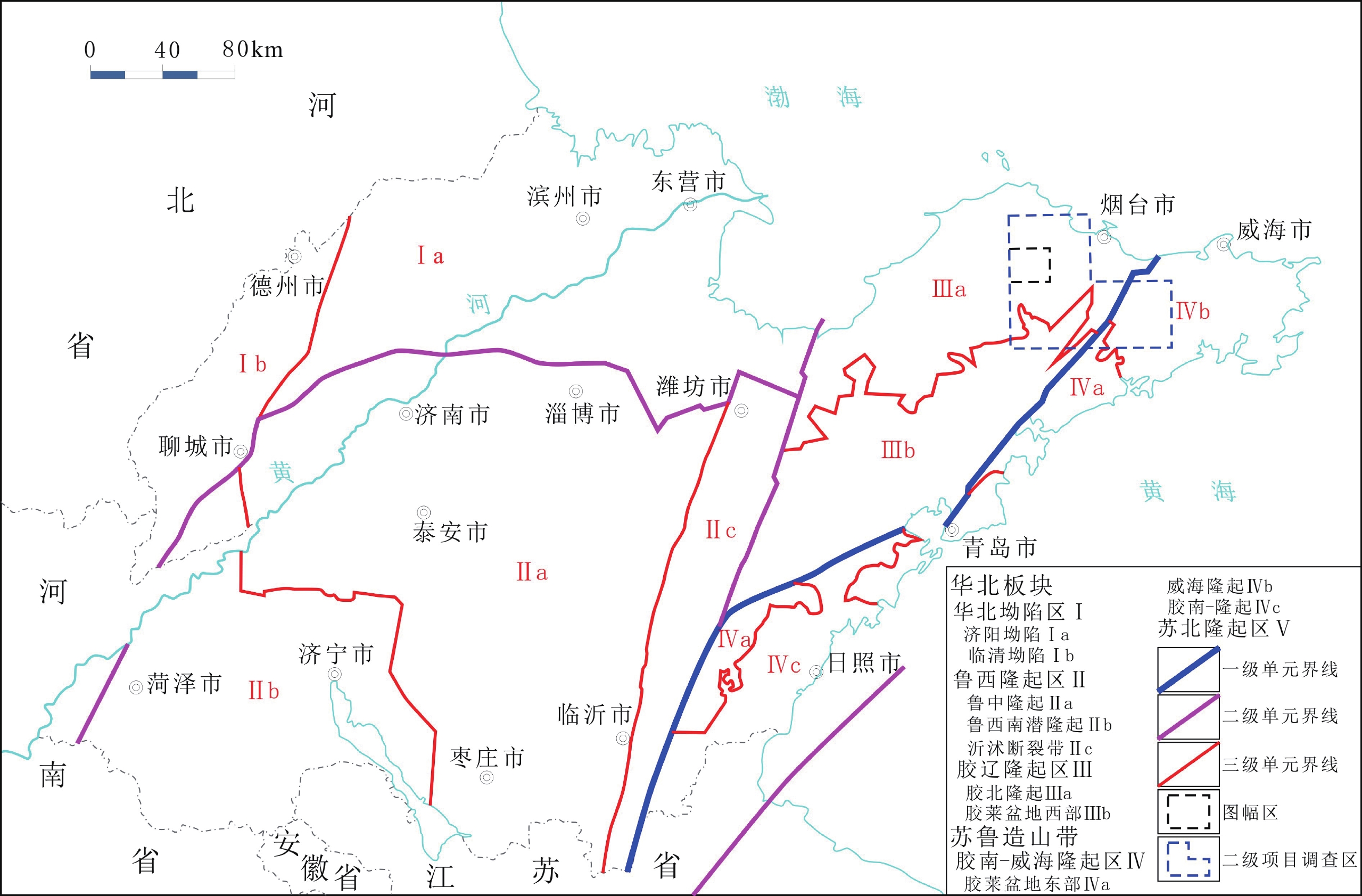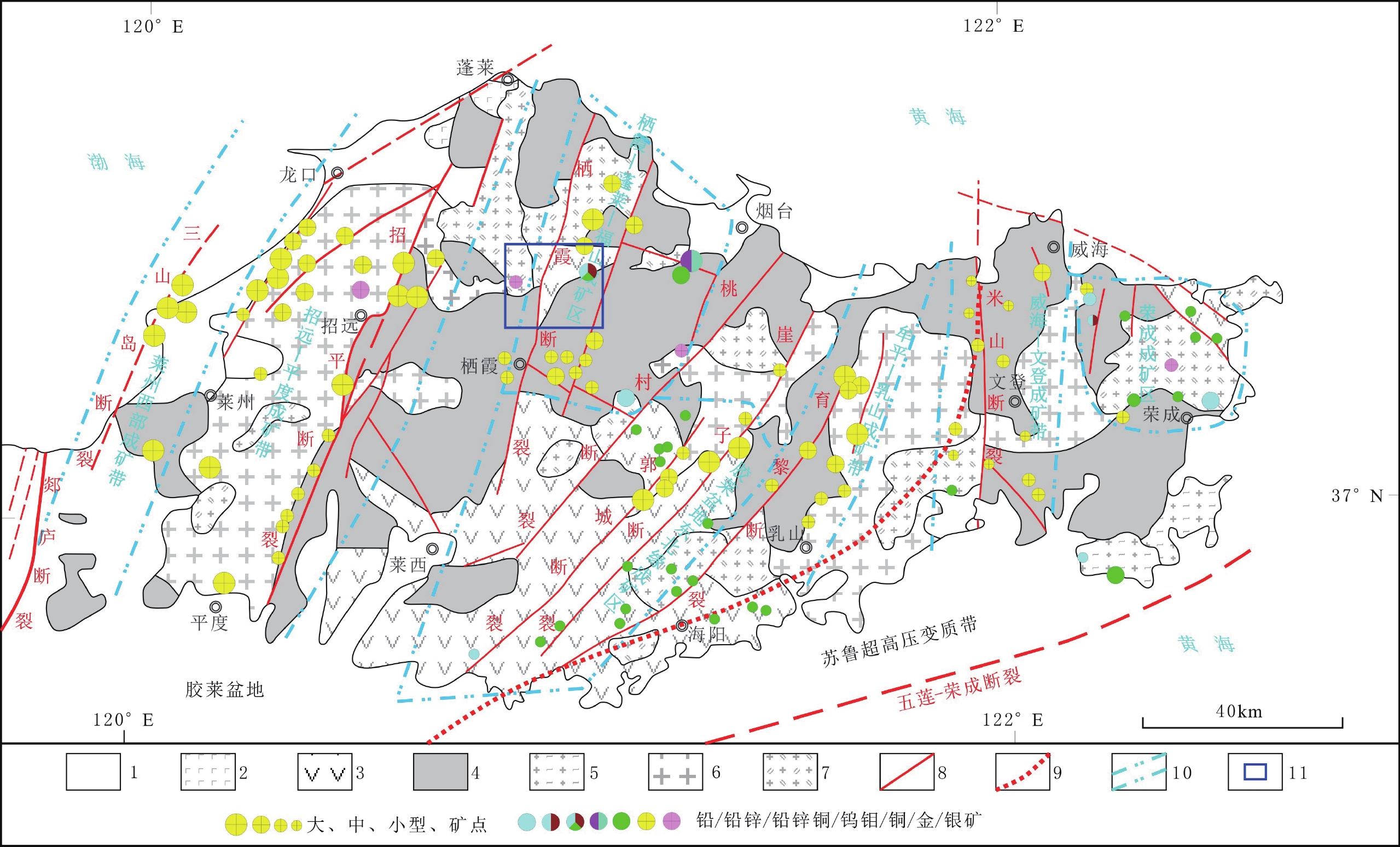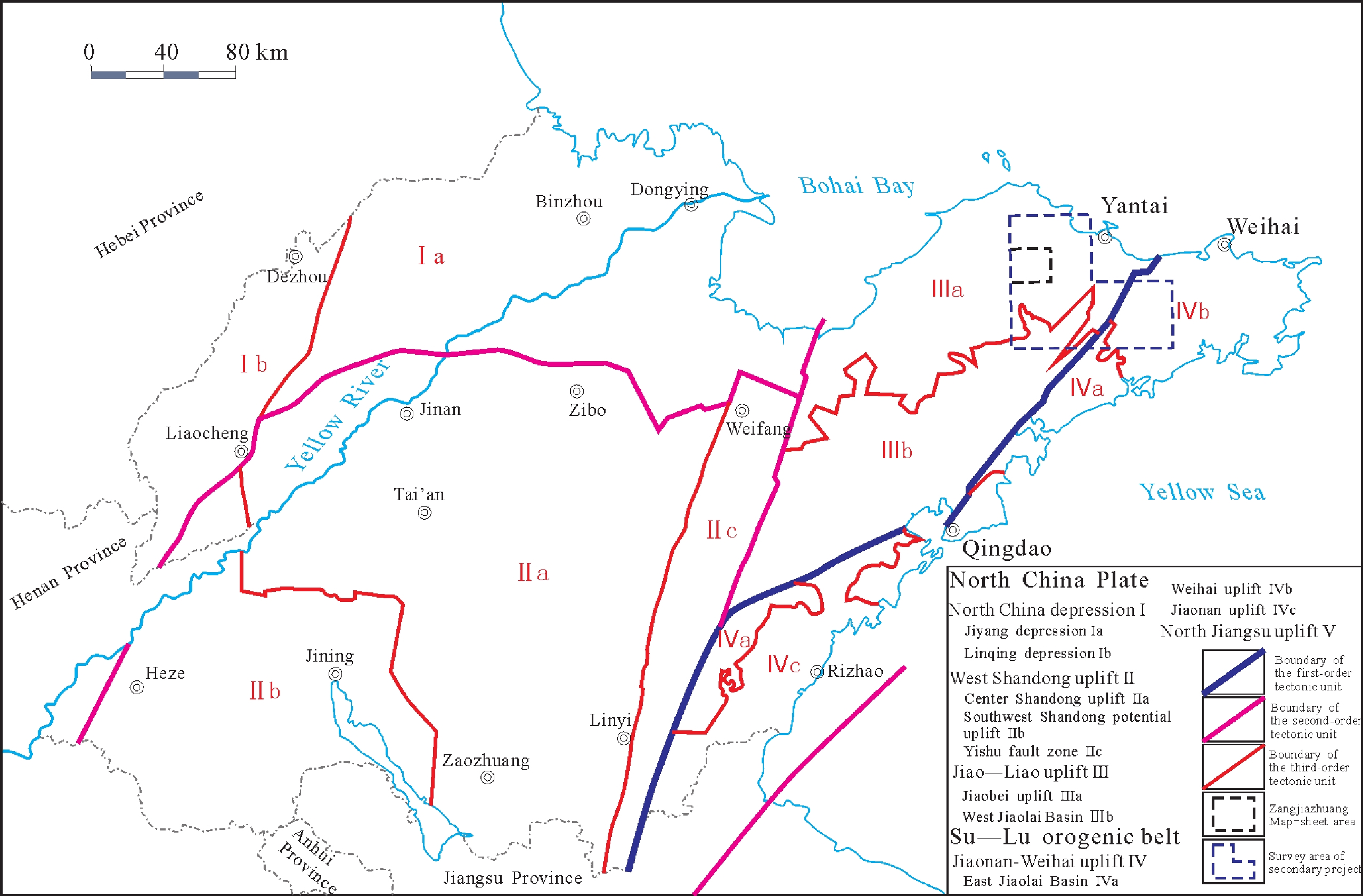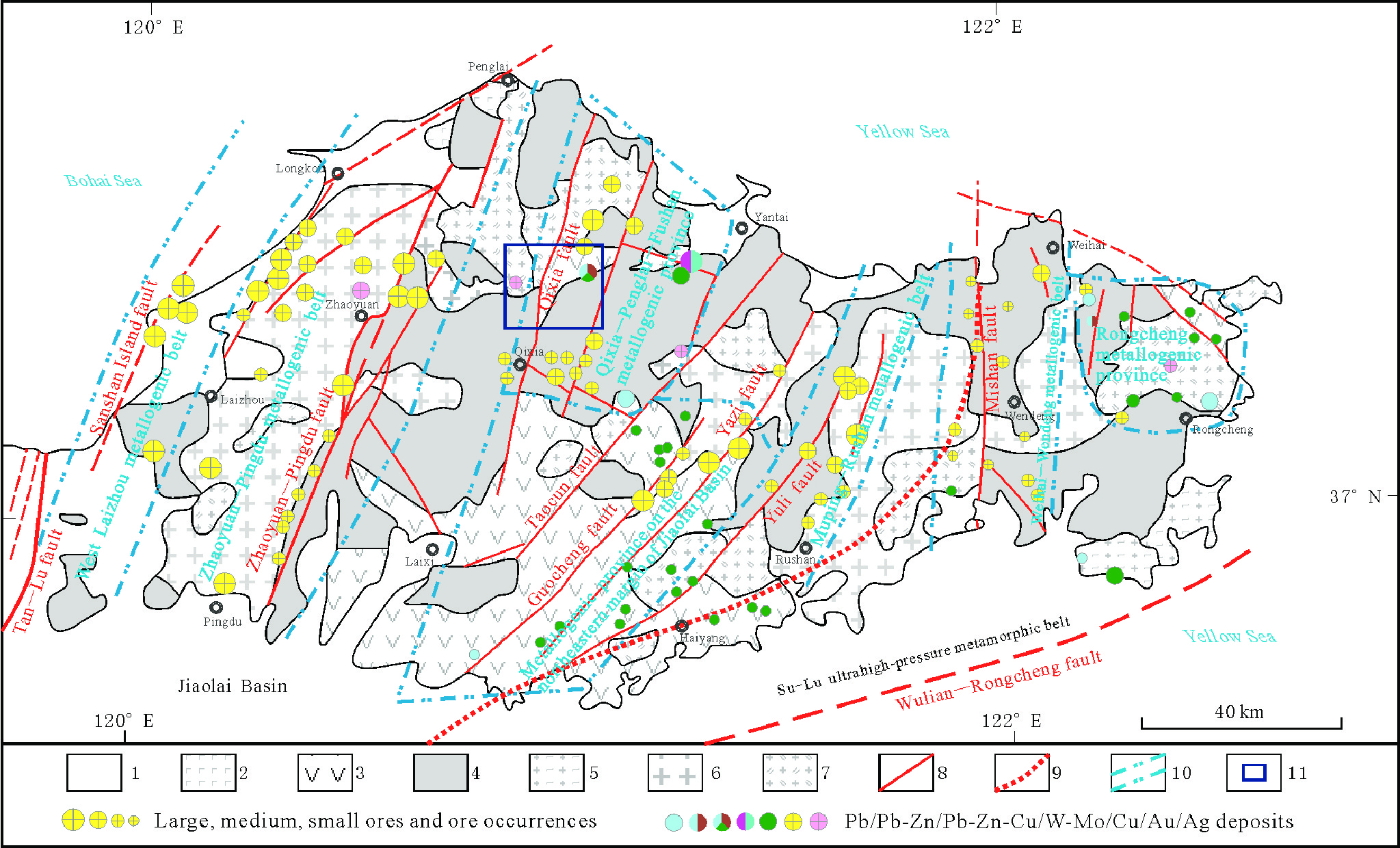1∶50 000 Mineral and Geological Map Database of Zangjiazhuang Map-sheet, Shandong Province
-
摘要:
山东省臧家庄幅(J51E016004)1∶50 000矿产地质图是根据《矿产地质调查技术要求(1∶50 000)》(DD2019−02)和《数字地质图空间数据库》(DD2006−06)以及相关的行业标准和要求,充分利用1∶50 000、1∶200 000等区域地质调查工作成果资料,采用数字填图系统进行野外数据采集,并应用室内编图和重点工作区野外实测相结合的方法编制完成。图幅数据库通过基本要素类、综合要素类、对象类以及独立要素类对数据进行分别存储。本文提出栖霞高家—香夼—福山邢家山为一多金属成矿带的新认识,成矿岩体为中生代酸性侵入岩,成矿受东西向构造与北北东向构造交汇部位控制。针对香夼多金属矿典型矿床成矿岩体进行的锆石LA−ICP−MS U−Pb测年表明其成矿年龄为127.91±0.58 Ma,为本区多金属成矿年龄和成矿规律研究提供了可靠的新数据。图幅数据库包含5个年龄数据,25个矿产地数据,其中新发现铜矿(化)点2处、金矿化点1处,提交了2个找矿靶区并圈定6个最小预测区,预测了资源量,Au 10 962 kg、Ag 499.638 t、Pb 141 437 t、Zn 230 011 t。臧家庄幅(J51E016004)1∶50 000矿产地质图数据库为该区地质找矿工作提供了基础数据支撑,并将为地质科学的信息化、网络化建设提供数据源。
Abstract:The 1∶50 000 mineral and geological map of Zangjiazhuang Map-sheet (J51E016004), Shandong Province was prepared according to applicable industry standards such as Technical Requirement of 1∶50 000 Solid Mineral Geological Survey (DD 2019-02) and Spatial Database for Digital Geological Map (DD 2006-06), during which the results of relevant 1∶50 000- and 1∶200 000-scale regional geological surveys were fully adopted. In addition, a digital mapping system was applied to acquire data in the field, and indoor map preparation was conducted in combination with field survey of key survey sites. The data in the 1∶50 000 mineral and geological map database of Zangjiazhuang Map-sheet, Shandong Province (also referred to as the Database) was individually stored according to four types of classes, namely feature classes, complex classes, object classes and independent feature classes. In this paper, a new polymetallic metallogenic belt located in Qixia, Yantai City was proposed, i.e., the Gaojia–Xiangkuang–Xingjiashan polymetallic metallogenic belt. This metallogenic belt, with Mesozoic acid intrusions as metallogenic intrusions, is under the control of the intersection of the EW- and NNE-trending faults. LA-ICP-MS zircon U-Pb dating of the metallogenic intrusions in typical Xiangkuang polymetallic deposits indicates that the metallogenic age of the metallogenic intrusions is 127.91±0.58 Ma, providing new credible data for research into the metallogenic ages and rules of the polymetallic deposits in Zangjiazhuang Map-sheet. The Database covers the data of five ages and 25 mineral deposits, including two copper ore occurrences and one gold mineralized point that were newly discovered. Meanwhile, two prospecting target areas were determined and six predicted minimum prospecting target areas were delineated. Furthermore, the resources of Au, Ag, Pb and Zn in the new polymetallic metallogenic belt were predicted to be 10 962 kg, 499.638 t, 141 437 t and 230 011 t, respectively. The Database could provide basic data for the geological prospecting in Zangjiazhuang Map-sheet, as well as data sources for information- and network-oriented construction of geology.
-

-
图 1 山东省臧家庄地区大地构造位置图(据张增奇等,2014)
图 2 山东省臧家庄地区成矿区带位置图(据丁正江等,2015a)
表 1 矿产地一览表
序号 名称 规模 类型 主要含矿建造构造 1 栖霞市臧家庄镇西林金矿 中型 潜火山热液裂隙充填交
代型近东西向断裂 2 栖霞市松山镇上艾口金矿 小型 石英脉型 近东西向糜棱岩带 3 蓬莱市村里集镇站马张家金矿 矿点 石英脉型 北东向断裂 4 蓬莱市村里集镇王格庄金矿 矿点 石英脉型 北北东向断裂 5 栖霞市臧家庄镇西尹家金矿 矿点 蚀变岩型 北东向断裂 6 栖霞市松山镇艾山汤金矿 矿点 石英脉型 北东向断裂 7 栖霞市松山镇下艾口金矿 矿点 石英脉型 北东向断裂 8 栖霞市庄园街道葛家沟金矿 矿点 石英脉型 北北东向断裂 9 栖霞城北张家沟金矿 矿点 石英脉型 北西西向糜棱岩带 10 栖霞市松山镇客落邹家金矿 矿点 石英脉型 北西西向糜棱岩带 11 栖霞市臧家庄镇蒙家金矿 矿化点 岩浆热液裂隙充填型 近东西向断裂 12 栖霞市松山镇金山泊子金矿 矿化点 石英脉型 北西向断裂 13 栖霞市庄园街道高家金矿 矿化点 石英脉型 北西向断裂 14 栖霞市亭口镇攻险顶金矿 矿化点 石英脉型 北东向断裂 15 栖霞市庄园街道和尚庄银矿 小型 岩浆热液充填型 粉子山群石墨二云片岩之北西西向断裂 16 栖霞市庄园街道高家北银矿 矿点 岩浆热液充填型 粉子山群石墨二云片岩之北西西向断裂 17 栖霞市臧家庄镇瓮留张家铜矿 矿点 岩浆热液充填型 白垩纪莱阳群砾岩 18 栖霞市臧家庄镇百佛院铜矿 矿化点 岩浆热液充填型 北北东向断裂 19 栖霞市臧家庄镇瓮留范家铜矿 矿点 岩浆热液充填型 白垩纪莱阳群砾岩 20 蓬莱市村里集镇小柱铜矿 矿化点 岩浆热液充填型 北北东向断裂 21 栖霞市臧家庄镇西山庄铅矿 矿点 岩浆热液充填型 近东西向断裂 22 蓬莱市村里集镇邓格庄铅矿 矿化点 岩浆热液充填型 白垩纪花岗岩之间的接触带 23 栖霞市臧家庄镇西林铅锌矿 矿化点 潜火山热液裂隙充填型 白垩纪花岗闪长斑岩与莱阳群接触带 24 栖霞市臧家庄镇香夼铜铅锌多金属矿 中型 矽卡岩–斑岩复合型 白垩纪花岗闪长斑岩与香夼组灰岩接触带 25 栖霞市松山镇郝家楼铜铅锌多金属矿 矿化点 矽卡岩型 白垩纪花岗闪长斑岩与豹山口组岩石接触带 表 2 数据库元数据简表
条目 描述 数据库(集)名称 山东省臧家庄幅1︰50 000矿产地质图数据库 数据(集)作者 朱学强,山东省地质调查院
戴广凯,山东省地质调查院
郭 晶,山东省地质调查院
刘 丽,山东省地质调查院数据时间范围 2016—2018年 地理区域 东经120°45′~121°00′,北纬37°20′~37°30′ 数据格式 MapGIS 数据量 36.5 MB 数据服务系统网址 http://dcc.cgs.gov.cn 基金项目 中国地质调查局矿产地质调查项目“山东1︰50 000大辛店幅、岗嵛幅、臧家庄幅、高疃幅矿产地质调查”(编号:DD20160044-1) 语种 中文 数据集组成 本数据集包括1︰50 000地质图库和图饰。地质图库包含基本要素类、综合要素类、对象类和独立要素类。其中基本要素类包括:地质体面实体、地质界线、矿产地、产状、样品、照片、同位素年龄、火山口、河、湖、海、水库岸线。综合要素类包括:构造变形带、蚀变带、变质相带、火山岩相带、标准图框。对象类包括:沉积(火山)地层单位、侵入岩岩石年代单位、断层、变质岩地(岩)层单位、特殊地质体、脉岩(面)、面状水域与沼泽、图幅基本信息。独立要素类主要包括图例、柱状图、图切剖面、接图表、典型矿床解剖图、矿产地名录、矿种及规模、所处成矿区带位置图、责任表等角图 表 3 同位素年龄数据一览表
序号 岩性 测试方法 年龄/Ma 数据来源 1 安山岩 黑云母K–Ar法 123 收集① 2 片麻状黑云二长花岗岩 锆石U–Pb法 2447 收集① 3 斜长角闪岩 Sm–Nd法 2938 收集① 4 花岗闪长斑岩 锆石LA-ICP-MS U–Pb法 127.91±0.58 中国地质调查局天津地质调查中心实验室 5 流纹斑岩 锆石LA-ICP-MS U–Pb法 114.14±0.78 中国地质调查局天津地质调查中心实验室 表 4 臧家庄(图幅号:J51E016004)幅基本要素类、综合要素类和对象类数据表
数据集 实体名称 文件名 文件数/个 数据类型 基本要素类 地质体面实体 _GEOPOLYGON.PM 904 Area 地质(界)线 _GEOLINE.LM 2550 Line 矿产地 _MINERAL_PNT.TM 25 Point 产状 _ATTITUDE.TM 138 Point 同位素测年 _ISOTOPE.TM 5 Point 火山口 _CRATER.TM 1 Point 河、湖、海、水库岸线 _LINE_GEOGRAPHY.LM 231 Line 综合要素类 构造变形带 _TECOZONE.PM 6 Area 蚀变带(面) _ALTERATION_POLYGON.PM 66 Area 变质相带 _METAMOR_FACIES.PM 230 Area 火山岩相带 _VOLCA_FACIES.PM 20 Area 标准图框(内图框) _MAP_FRAME 4 Line 对象类 沉积(火山)岩岩石地层单位 _STRATA 8 ACCESS 侵入岩岩石年代单位 _INTRU_LITHO_CHRONO 21 ACCESS 断层 _FAULT 10 ACCESS 变质岩地(岩)层单位 _METAMORPHIC 8 ACCESS 特殊地质体 _SPECIAL_GEOBODY 6 ACCESS 脉岩(面) _DIKE_OBJECT 17 ACCESS 面状水域与沼泽 _WATER_REGION 4 ACCESS 图幅基本信息 _SHEET_MAPINFO 1 ACCESS Table 1. List of 25 mineral deposits recently discovered in the Zangjiazhuang area
Code Mineral deposit name Scale Deposit type Main ore-bearing suites and structures 1 Xilin gold deposit in Zangjiazhuang Town, Qixia City Medium Subvolcanic hydrothermal fracture-filling and metasomatic type Near EW-trending fault 2 Shangaikou gold deposit in Songshan Town, Qixia City Small Quartz vein type Near EW-trending mylonite zone 3 Zhanmazhangjia gold deposit in Cunliji Town, Penglai City Ore occurrence Quartz vein type NE-trending fault 4 Wanggezhuang gold deposit in Cunliji Town, Penglai City Ore occurrence Quartz vein type NNE-trending fault 5 Yinjia gold deposit in Zangjiazhuang Town, Qixia City Ore occurrence Altered rock type NE-trending fault 6 Aishantang gold deposit in Songshan Town, Qixia City Ore occurrence Quartz vein type NE-trending fault 7 Xia’aikou gold deposit in Songshan Town, Qixia City Ore occurrence Quartz vein type NE-trending fault 8 Gejiagou gold deposit, Zhuangyuan Street, Qixia City Ore occurrence Quartz vein type NNE-trending fault 9 Zhangjiagou gold deposit, northern Qixia Ore occurrence Quartz vein type NWW-trending mylonite zone 10 Keluozoujia gold deposit in Songshan Town, Qixia City Ore occurrence Quartz vein type NWW-trending mylonite zone 11 Mengjia gold deposit in Zangjiazhuang Town, Qixia City Mineralized point Magmatic hydrothermal fracture-filling type Near EW-trending fault 12 Jinshanbozi gold deposit in Songshan Town, Qixia City Mineralized point Quartz vein type NW-trending fault 13 Gaojia gold deposit, Zhuangyuan Street, Qixia City Mineralized point Quartz vein type NW-trending fault 14 Gongxianding gold deposit, Tingkou Town, Qixia City Mineralized point Quartz vein type NE-trending fault 15 Heshangzhuang silver deposit in Zhuangyuan Street, Qixia City Small Magmatic hydrothermal fracture-filling type NWW-trending fault of the graphite-two mica schist of the Fenzishan Group 16 Gaojiabei silver deposit in Zhuangyuan Street, Qixia City Ore occurrence Magmatic hydrothermal fracture-filling type NWW-trending fault of the graphite-two mica schist of the Fenzishan Group 17 Wengliuzhangjia copper deposit in Zangjiazhuang Town, Qixia City Ore occurrence Magmatic hydrothermal fracture-filling type Cretaceous Laiyang Group conglomerate 18 Baifoyuan copper deposit in ZangjiazhuangTown, Qixia City Mineralized point Magmatic hydrothermal fracture-filling type NNE-trending fault 19 Wengliufanjia copper deposit in Zangjiazhuang Town, Qixia City Ore occurrence Magmatic hydrothermal fracture-filling type Cretaceous Laiyang Group conglomerate 20 Xiaozhu copper deposit in Cuoliji Town, Penglai City Mineralized point Magmatic hydrothermal fracture-filling type NNE-trending fault 21 Xishanzhuang lead deposit in Zangjiazhuang Town, Qixia City Ore occurrence Magmatic hydrothermal fracture-filling type Near EW-trending fault 22 Denggezhuang lead deposit in Cunliji Town, Penglai City Mineralized point Magmatic hydrothermal fracture-filling type Contact zone between Cretaceous granites 23 Xilin lead–zinc deposit in Zangjiazhuang Town, Qixia City Mineralized point Subvolcanic hydrothermal fissure filling and replacement Contact zone between Cretaceous granodiorite porphyry and Laiyang Group 24 Xiangkuang copper–lead–zinc polymetallic deposit in Zangjiazhuang Town, Qixia City Medium Skarn–porphyry complex type Contact zone between Cretaceous granodiorite porphyry and the limestone of Xiangkuang Formation 25 Haojialou copper–lead–zinc polymetallic deposit in Songshan Town, Qixia City Mineralized point Skarn type Contact zone between Cretaceous granodiorite porphyry and Baoshankou Formation Table 2. Metadata Table of Database (Dataset)
Items Description Database (dataset) name 1∶50 000 Mineral and Geological Map Database of Zangjiazhuang Map-sheet, Shandong Province Database (dataset) authors Zhu Xueqiang, Shandong Institute of Geological Survey
Dai Guangkai, Shandong Institute of Geological Survey
Guo Jing, Shandong Institute of Geological Survey
Liu Li, Shandong Institute of Geological SurveyData acquisition time From 2016 to 2018 Geographical area 120°45′–121°00′E, 37°20′–37°30′N Data format MapGIS Data size 36.5 MB Data service system URL http://dcc.cgs.gov.cn Fund project Mineral and geological survey project entitled 1∶50 000-scale Mineral and Geological Survey of Daxindian Map-sheet, Gangyu Map-sheet, Zangjiazhuang Map-sheet and Gaotuan Map-sheet, Shandong Province (No.: DD20160044-1) initiated by the China Geological Survey Language Chinese Database (dataset) composition The Database consists of 1∶50 000 geological map library and map decorations. The geological map library includes feature classes, object classes, complex classes and independent feature classes. The feature classes include geological polygon entities, geological boundaries, mineral deposits, attitude, samples, photos, isotopic ages, craters, shorelines of rivers, lakes, seas, and reservoirs. Complex classes include tectonic deformation zone, alteration zones, metamorphic facies zones, volcanic facies zones, standard map frames. Object classes include sedimentary (volcanic) rocks, chronologic unit of intrusions, faults, petrostratigraphic units of metamorphic rocks, special geological bodies, dike (sections), planar waters and swamps, basic information of the map-sheet. Independent feature classes include the corner maps such as legends, diagrams, transverse cutting profiles, an index map, profiles of typical deposits, the name list/mineral types/scale of mineral deposits, location map of metallogenic belt the map-sheet is located, and duty table Table 3. List of isotopic dating samples and related information
Code Lithology Datig method Age/Ma Data source 1 Andesite Biotite K–Ar dating 123 Collected from the reference① 2 Gneissic biotite monzonitic granite Zircon U–Pb dating 2447 Collected from the reference① 3 Plagioclase amphibolite Sm–Nd dating 2938 Collected from the reference① 4 Granodioritic porphyry Zircon LA-ICP-MS
U–Pb dating127.91±0.58 The laboratory of Tianjin Center, China Geological Survey 5 Rhyolitic porphyry Zircon LA-ICP-MS
U–Pb dating114.14±0.78 The laboratory of Tianjin Center, China Geological Survey Table 4. Data Tables of the Feature Classes, Complex Classes, and Object Classes of Zangjiazhuang Map-sheet (J51E016004)
Dataset Entity name File name File number Data type Feature classes Geological polygon entity _GEOPOLYGON.PM 904 Area Geological (boundary) line _GEOLINE.LM 2550 Line Mineral deposit _MINERAL_PNT.TM 25 Point Attitude _ATTITUDE.TM 138 Point Isotopic dating _ISOTOPE.TM 5 Point Crater _CRATER.TM 1 Point Shoreline of river, lake, sea, or reservoir _LINE_GEOGRAPHY.LM 231 Line Complex classes Tectonic deformation zone _TECOZONE.PM 6 Area Alteration zone (section) _ALTERATION_POLYGON.PM 66 Area Metamorphic facies zone _METAMOR_FACIES.PM 230 Area Volcanic facies zone _VOLCA_FACIES.PM 20 Area Standard map frame (inner map frame) _MAP_FRAME 4 Line Object classes Petrostratigraphic unit of sedimentary (volcanic) rocks _STRATA 8 ACCESS Chronologic unit of intrusions _INTRU_LITHO_CHRONO 21 ACCESS Fault _FAULT 10 ACCESS Petrostratigraphic unit of metamorphic rocks _METAMORPHIC 8 ACCESS Special geological body _SPECIAL_GEOBODY 6 ACCESS Dike (section) _DIKE_OBJECT 17 ACCESS Planar waters and swamp _WATER_REGION 4 ACCESS Basic information of the Map-sheet _SHEET_MAPINFO 1 ACCESS -
[1] Li S Z, Zhao G C, Santosh M, Liu X, Dai L M, Suo Y H, Tam P Y, Song M C, Wang P C. 2012. Paleoproterozoic structural evolution of the southern segment of the Jiao-Liao-Ji Belt, North China Craton[J]. Precambrian Research, 200: 59−73.
[2] Li X H, Chen F K, Guo J H, Li Q L, Xie L W, Siebel W. 2007. South China provenance of the Lower-grade Penglai Group north of the Sulu UHP orogenic belt, eastern China: evidence from detrital zircon ages and Nd-Hf isotopic composition[J]. Geochemical Journal, 41: 29−45. doi: 10.2343/geochemj.41.29
[3] Tam P Y, Zhao G C, Liu F L, Zhou X W, Sun M, Li S S. 2011. Timing of metamorphism in the Paleoproterozoic Jiao-Liao-Ji Belt: new SHRIMP U−Pb zircon dating of granulites, gneisses and marbles of the Jiaobei massif in the North China Craton[J]. Gondwana Research, 19: 150−162. doi: 10.1016/j.gr.2010.05.007
[4] Zhao G C, Sun M, Wlide S A, Li S Z. 2005. Late Archean to Paleoproterozoic evolution of the North China Craton: key issues revisited[J]. Precambrian Research, 136: 177−202. doi: 10.1016/j.precamres.2004.10.002
[5] Zhou J B, Wilde S A, Zhao GC, Zheng C Q., Wei J, Zhang X Z, Cheng H 2008. SHRIMP U−Pb zircon dating of the Neoproterozoic Penglai Group and Archean gneisses from the Jiaobei Terrane, North China, and their tectonic implication[J]. Precambrian Research, 160: 323−340. doi: 10.1016/j.precamres.2007.08.004
[6] 陈安蜀, 李效广, 高晓红. 2008. 1︰25万区域地质图空间数据库建设——以1︰25万都兰县幅建库为例[J]. 地质调查与研究, 31(1): 64−69. doi: 10.3969/j.issn.1672-4135.2008.01.011
[7] 丁正江, 孙丰月, 刘福来, 刘建辉, 彭齐鸣, 纪攀, 李碧乐, 张丕建. 2015a. 胶东中生代动力学演化及主要金属矿床成矿系列[J]. 岩石学报, 31(10): 3045−3080. https://www.cnki.com.cn/Article/CJFDTOTAL-YSXB201510011.htm
[8] 丁正江, 孙丰月, 李国华, 纪攀, 孔彦. 2015b. 胶东邢家山地区燕山早期钼钨成矿母岩锆石U−Pb年龄及其意义[J]. 中国地质, 42(2): 556−569. doi: 10.3969/j.issn.1000-3657.2015.02.015
[9] 郭晶, 朱学强, 任天龙, 戴广凯. 2019. 山东栖霞香夼地区多金属硫化物矿床外围隐爆——侵入角砾岩的发现及意义[J]. 山东国土资源, 35(1): 19−24. https://www.cnki.com.cn/Article/CJFDTOTAL-SDDI201901004.htm
[10] 胡品三. 1987. 山东香夼多金属硫化物矿床分带特征和成矿机制的探讨[J]. 唐山工程技术学院学报, (3): 25−33. https://www.cnki.com.cn/Article/CJFDTOTAL-HBLG198703003.htm
[11] 李晨阳, 王新春, 何春珍, 吴轩, 孔昭煜, 李晓蕾. 2019. 全国1︰200 000数字地质图(公开版)空间数据[J]. 中国地质, 46(S1): 1−10. doi: 10.12029/gc2019Z101
[12] 李杰, 宋明春, 王美云, 李世勇, 周明岭, 倪师军, 张成江, 丁正江, 岳跃破. 2013. 胶东尚家庄钼矿床Re−Os同位素年龄及其地质意义[J]. 中国地质, 40(5): 1612−1621. doi: 10.3969/j.issn.1000-3657.2013.05.024
[13] 梁凤华, 许志琴, 李忠海, 陈方远. 2011. 胶北地体中的深层次拆离构造: 扬子板片折返的板上响应[J]. 岩石学报, 27(4): 969−979. https://www.cnki.com.cn/Article/CJFDTOTAL-YSXB201104010.htm
[14] 刘翠辉, 于长琦, 贺根文, 李伟, 刘孝斌. 2019. 赣南宁都地区1︰50 000青塘幅矿产地质图数据集[J]. 中国地质, 46(S1): 75−83. doi: 10.12029/gc2019Z109
[15] 卢文姬, 孔祥超, 蓝信杰, 张丽君, 连舒婷, 辛魏. 2016. 山东栖霞香夼矿床深部地球化学成矿机理[J]. 地质与勘探, 52(6): 1095−1106. https://www.cnki.com.cn/Article/CJFDTOTAL-DZKT201606010.htm
[16] 马明, 吴涵宇, 陈刚. 2017. 华东地区1︰5万区域地质图空间数据库建设及应用[J]. 华东地质, 38(3): 228−233. https://www.cnki.com.cn/Article/CJFDTOTAL-HSDZ201703010.htm
[17] 宋明春, 宋英昕, 李杰, 李世勇. 2015. 胶东与白垩纪花岗岩有关的金及有色金属矿床成矿系列[J]. 大地构造与成矿学, 39(5): 828−843. https://www.cnki.com.cn/Article/CJFDTOTAL-DGYK201505007.htm
[18] 宋英昕, 宋明春, 李世勇, 李杰, 丁正江, 谭现峰. 2019. 胶东晚中生代三期成矿岩体和3.5 Ga锆石的发现及成矿动力学背景[J]. 地质学报, 93(2): 440−458. doi: 10.3969/j.issn.0001-5717.2019.02.012
[19] 孙丰月, 丁正江, 刘殿浩, 张丕建, 于晓飞. 2011. 初论胶东福山北部地区斑岩成矿系统[J]. 黄金, 32(1): 14−19. doi: 10.3969/j.issn.1001-1277.2011.01.004
[20] 汪山. 1984. 山东栖霞香夼古火山机构及其成矿特征[J]. 吉林地质, 3(2): 31−40. https://www.cnki.com.cn/Article/CJFDTOTAL-JLDZ198402004.htm
[21] 王成辉, 王登红, 黄凡, 徐钰, 陈郑辉, 应立娟, 刘善宝. 2012. 中国金矿集区及其资源潜力探讨[J]. 中国地质, 39(5): 1125−1142. doi: 10.3969/j.issn.1000-3657.2012.05.002
[22] 王春女, 杜泽忠, 于晓飞, 李永胜, 吕鑫, 孙海瑞, 杜轶伦. 2019. 甘肃省花牛山幅1︰50 000矿产地质图数据库[J]. 中国地质, 46(S1): 55−65. doi: 10.12029/gc2019Z107
[23] 王奎峰. 2008. 胶东栖霞香夼铅锌多金属矿床地质特征及成因[J]. 地质调查与研究, 31(2): 89−96. doi: 10.3969/j.issn.1672-4135.2008.02.002
[24] 薛玉山, 柳振江, 成少博, 朱保霖. 2014. 胶东邢家山大型钼矿地质地球化学特征及成因意义[J]. 中国地质, 41(2): 540−561. doi: 10.3969/j.issn.1000-3657.2014.02.017
[25] 薛志忠. 1999. 胶北臧家庄盆地中生代火山岩及火山活动特征[J]. 山东地质, 15(4): 11−17. https://www.cnki.com.cn/Article/CJFDTOTAL-SDDI199904002.htm
[26] 杨立强, 邓军, 王中亮, 张良, 郭林楠, 宋明春, 郑晓礼. 2014. 胶东中生代金成矿系统[J]. 岩石学报, 30(9): 2447−2467. https://www.cnki.com.cn/Article/CJFDTOTAL-YSXB201409001.htm
[27] 于学峰, 李洪奎, 单伟. 2012. 山东胶东矿集区燕山期构造热事件与金矿成矿耦合探讨[J]. 地质学报, 86(12): 1946−1956. doi: 10.3969/j.issn.0001-5717.2012.12.007
[28] 张乾. 1990. 山东香夼斑岩型铅锌矿床的地球化学特征及成因探讨[J]. 地质找矿论丛, 5(2): 12−19. https://www.cnki.com.cn/Article/CJFDTOTAL-DZZK199002001.htm
[29] 张增奇, 张成基, 王世进, 刘书才, 王来明, 杜胜贤, 宋志勇, 张尚坤, 杨恩秀, 程光锁, 刘凤臣, 陈军, 陈诚. 2014. 山东省地层侵入岩构造单元划分对比意义[J]. 山东国土资源, 30(3): 1−23. doi: 10.3969/j.issn.1672-6979.2014.03.001
[30] 周喜文, 魏春景, 耿元生, 张立飞. 2004. 胶北栖霞地区泥质高压麻粒岩的发现及其地质意义[J]. 科学通报, 29(14): 1424−1430. doi: 10.3321/j.issn:0023-074X.2004.14.015
[31] 朱学强, 戴广凯, 郭晶, 刘丽. 2020. 山东省臧家庄幅 1∶50 000 矿产地质图数据库[DB/OL]. 地质科学数据出版系统. (2020-12-30). DOI: 10.35080/data.C.2020.P27.
[1] Chen Anshu, Li Xiaoguang, Gao Xiaohong. 2008. 1∶250 000-scale regional geological map spatial database[J]. Geological Survey and Research, 31(1): 64−69 (in Chinese with English abstract). http://en.cnki.com.cn/Article_en/CJFDTOTAL-QHWJ200801010.htm
[2] Ding Zhengjiang, Sun Fengyue, Liu Fulai, Liu Jianhui, Peng Qiming, Ji Pan, Li Bile, Zhang Peijian. 2015a. Mesozoic geodanamic evolution and metallogenic series of major metal deposits in Jiaodong Peninsula, China[J]. Acta Petrologica Sinica, 31(10): 3045−3080 (in Chinese with English abstract). http://www.zhangqiaokeyan.com/academic-journal-cn_acta-petrologica-sinica_thesis/0201252016378.html
[3] Ding Zhengjiang, Sun Fengyue, Li Guohua, Ji Pan, Kong Yan. 2015b. Accurate zircon U-Pb dating of early Yanshanian molybdenum-tungeten mother rocks in Xingjiashan area of Jiaodong Peninsula and its significance[J]. Geology in China, 42(2): 556−569 (in Chinese with English abstract). http://en.cnki.com.cn/Article_en/CJFDTOTAL-DIZI201502015.htm
[4] Guo Jing, Zhu Xueqiang, Ren Tianlong, Dai Guangkai. 2019. Discovery and significance of cryptoexplosive intrusive breccia in Xiangkuang polymetallic sulfide deposit in Qixia area of Shandong Province[J]. Shandong Land and Resources, 35(1): 19−24 (in Chinese with English abstract). http://en.cnki.com.cn/Article_en/CJFDTotal-SDDI201901004.htm
[5] Hu Pinsan. 1987. A study of zoning character and metallogenetic mechanism of the polymetallic sulfide deposit in Xiangkuang, Shandong[J]. Journal of Tangshan Institute of Engineering and Technology, (3): 25−33 (in Chinese with English abstract). http://en.cnki.com.cn/Article_en/CJFDTotal-HBLG198703003.htm
[6] Li Chenyang, Wang Xinchun, He Chunzhen, Wu Xuan, Kong Zhaoyu, Li Xiaolei. 2019. China national digital geological map (public version at 1∶200 000 Scale) spatial database[J]. Geology in China, 46(S1): 1−14.
[7] Li Jie, Song Mingchun, Wang Meiyun, Li Shiyong, Zhou Mingling, Ni Shijun, Zhang Chengjiang, Ding Zhengjiang, Yue Yuepo. 2013. The molybdenite Re-Os age and genetic analysis of the Shangjiazhuang Mo Deposit in Jiaodong area[J]. Geology in China, 40(5): 1612−1621 (in Chinese with English abstract). http://www.zhangqiaokeyan.com/academic-journal-cn_journal-jilin-university-earth-science-edition_thesis/0201247968429.html
[8] Li Sanzhong, Zhao Guochun, Santosh M., Liu Xin, Dai Liming, Suo Yanhui, Tam Pui Yuk, Song Mingchun, Wang Peicheng 2012. Paleoproterozoic structural evolution of the southern segment of the Jiao-Liao-Ji Belt, North China Craton[J]. Precambrian Research, 200: 59−73. http://www.sciencedirect.com/science/article/pii/S0301926812000125
[9] Li Xianghui, Chen Fukun, Guo Jinghui, Li Qiuli, Xie Liewen, Wolfgang Siebel. 2007. South China provenance of the lower-grade Penglai Group north of the Sulu UHP orogenic belt, eastern China: evidence from detrital zircon ages and Nd-Hf isotopic composition[J]. Geochemical Journal, 41: 29−45. doi: 10.2343/geochemj.41.29
[10] Liang Fenghua, Xu Zhiqin, Li Zhonghai, Chen Fangyuan. 2011. Deep-level ductile detachment system in the Jiaobei terrain, eastern China: deformation response of the overlying plate during the exhumation of Yangtze Plate[J]. Acta Petrologica Sinica, 27(4): 969−979 (in Chinese with English abstract). http://en.cnki.com.cn/Article_en/CJFDTOTAL-YSXB201104010.htm
[11] Liu Cuihui, Yu Changqi, He Genwen, Li Wei, Liu Xiaobin. 2019. The 1∶50 000 mineral geological map dataset of the Qingtang Map-sheet, Ningdu, south Jiangxi[J]. Geology in China, 46(S1): 1000−111.
[12] Lu Wenji, Kong Xiangchao, Lan Xinjie, Zhang Lijun, Lian Shuting, Xin Wei. 2016. Geochemical metallogenic mechanism of the deep Xiangkuang deposit in the Qixia area of Shandong Province[J]. Geology and Exploration, 52(6): 1095−1106 (in Chinese with English abstract).
[13] Ma Ming, Wu Hanyu, Chen Gang. 2017. Construction of 1∶50 000 regional geological map database in East China and its application[J]. East China Geology, 38(3): 228−233 (in Chinese with English abstract). http://en.cnki.com.cn/Article_en/CJFDTotal-HSDZ201703010.htm
[14] Song Mingchun, Song Yingxin, Li Jie, Li Shiyong. 2015. Metallogenic series of gold and nonferrous metal deposits related to Cretaceous granites in eastern Shandong Peninsula, China[J]. Geotectonica et Metallogenia, 39(5): 828−843 (in Chinese with English abstract).
[15] Song Yingxin, Song Mingchun, Li Shiyong, Li Jie, Ding Zhengjiang, Tan Xianfeng. 2019. The discovery of three-stage late Mesozoic metallogenic granitic bodies and 3.5 Ga zircon in the Jiaodong terrane and their metallogenetic geodynamical setting[J]. Acta Geologica Sinica, 93(2): 440−458 (in Chinese with English abstract).
[16] Sun Fengyue, Ding Zhengjiang, Liu Dianhao, Zhang Pijian, Yu Xiaofei. 2011. Discussion on the porphyry metallogenic system in north Fushan Area, Jiaodong Peninsula[J]. Gold, 32(1): 14−19 (in Chinese with English abstract). http://en.cnki.com.cn/Article_en/CJFDTOTAL-HJZZ201101006.htm
[17] Tam Pui Yuk, Zhao Guochun, Liu Fulai, Zhou Xiwen, Sun Ming, Li Sisui. 2011. Timing of Metamorphism in the Paleoproterozoic Jiao-Liao-Ji Belt: New SHRIMP U-Pb Zircon Dating of Granulites, Gneisses and Marbles of the Jiaobei Massif in the North China Craton[J]. Gondwana Research, 19: 150−162. doi: 10.1016/j.gr.2010.05.007
[18] Wang Chenghui, Wang Denghong, Huang Fan, Xu Yu, Chen Zhenghui, Ying Lijuan, Liu Shanbao. 2012. The major gold concentration areas in China and their resource potentials[J]. Geology in China, 39(5): 1125−1142 (in Chinese with English abstract). http://en.cnki.com.cn/Article_en/CJFDTOTAL-DIZI201205001.htm
[19] Wang Chunnyu, Du Zezhong, Yu Xiaofei, Li Yongsheng, Lyu Xin, Sun Hairui, Du Yilun. 2019. 1∶50 000 mineral geological map database of the Huaniushan Map-sheet, Gansu[J]. Geology in China, 46(S1): 72−86 (in Chinese with English abstract).
[20] Wang Kuifeng. 2008. Geochemical characteristics and origin of the Xiangkuang lead-zinc polymetallic deposit in Qixia City, eastern Shandong Province[J]. Geological Survey and Research, 31(2): 89−96 (in Chinese with English abstract).
[21] Wang Shan. 1984. Paleovolcanic mechanism and metallogenic characteristics of Xiangkuang, Qixia, Shandong Province[J]. Jilin Geology, 3(2): 31−40 (in Chinese).
[22] Xue Yushan, Liu Zhenjiang, Cheng Shaobo, Zhu Baolin. 2014. Geological-geochemical characteristics of the Xingjiashan Mo deposit in Jiaodong and their geological significance[J]. Geology in China, 41(2): 540−561 (in Chinese with English abstract). http://en.cnki.com.cn/Article_en/CJFDTOTAL-DIZI201402017.htm
[23] Xue Zhizhong. 1999. Characteristics of Mesozoic volcanic rocks and volcanic activities in Zangjiazhuang Basin in Jiaobei[J]. Shandong Geology, 15(4): 11−17 (in Chinese with English abstract). http://search.cnki.net/down/default.aspx?filename=SDDI199904002&dbcode=CJFD&year=1999&dflag=pdfdown
[24] Yang Liqiang, Deng Jun, Wang Zhongliang, Zhang Liang, Guo Linnan, Song Mingchun, Zheng Xiaoli. 2014. Mesozoic gold metallogenic system of the Jiaodong gold province, eastern China[J]. Acta Petrologica Sinica, 30(9): 2447−2467 (in Chinese with English abstract). http://en.cnki.com.cn/Article_en/CJFDTOTAL-YSXB201409001.htm
[25] Yu Xuefeng, Li Hongkui, Shan Wei. 2012. Study on coupling between Yanshannian tectonic thermal events and gold mineralization in Jiaodong ore concentrating area in Shandong Province[J]. Acta Geologica Sinica, 86(12): 1946−1956 (in Chinese with English abstract). http://en.cnki.com.cn/Article_en/ http://search.cnki.net/down/default.aspx?filename=DZXE201212008&dbcode=CJFD&year=2012&dflag=pdfdown
[26] Zhang Qian. 1990. Lead-zinc deposit in Shandong Province and discussion on its genesis[J]. Contributions to Geology and Mineral Resources Research, 5(2): 12−19 (in Chinese).
[27] Zhang Zengqi, Zhang Chengji, Wang Shijin, Liu Shucai, Wang Laiming, Du Shengxian, Song Zhiyong, Zhang Shangkun, Yang Enxiu, Cheng Guangsuo, Liu Fengchen, Chen Jun, Chen Cheng. 2014. Views on classification and contrast of tectonic units in strata in Shandong Province[J]. Shangdong Land and Resources, 30(3): 1−23 (in Chinese with English abstract).
[28] Zhao Guochun, Sun Min, Simon A.Wlide, Li Sanzong 2005. Late Archean to Paleoproterozoic Evolution of the North China Craton: Key Issues Revisited[J]. Precambrian Research, 136: 177−202. doi: 10.1016/j.precamres.2004.10.002
[29] Zhou Jianbo, Simon A.Wilde, Zhao Guochun, Zheng Changqing, Wei Jin, Zhang Xingzhou, Cheng Hong 2008. SHRIMP U-Pb zircon dating of the Neoproterozoic Penglai Group and Archean gneisses from the Jiaobei Terrane, North China, and their tectonic implication[J]. Precambrian Research, 160: 323−340. doi: 10.1016/j.precamres.2007.08.004
[30] Zhou Xiwen, Wei Chunjing, Geng Yuansheng, Zhang Lifei. 2004. Discovery of the high-pressure pelitic granulite from the Jiaobei and its implications[J]. Chinese Science Bulletin, 29(14): 1424−1430 (in Chinese). doi: 10.1007%2FBF03184286
[31] Zhu Xueqiang, Dai Guangkai, Guo Jing, Liu Li. 2020. 1∶50 000 Mineral and Geological Map Database of Zangjiazhuang Map-sheet, Shandong Province[DB/OL]. Geoscientific Data & Discovery Publishing System. (2020-12-30). DOI: 10.35080/data.C.2020.P27.
-




 下载:
下载:


